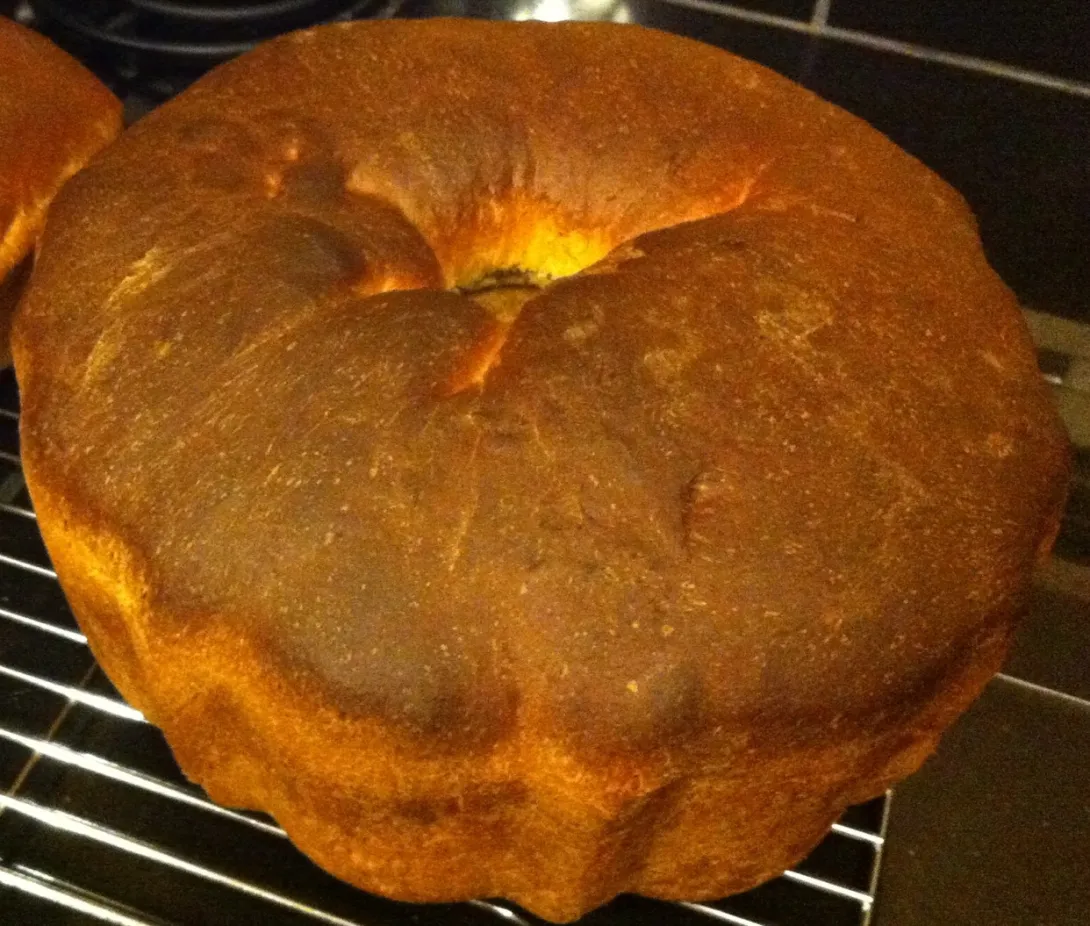
Posted below is the recipe I use for my Portuguese sweet bread. I am interested in suggestions from the collective audience that may result in improvements in taste, texture, oven spring, etc.
In my last bake I used about 50g of leftover levain ... not sure it made any difference and it might be interesting to experiment with adding even more to assess its affects on the final product.
Regards-
Dave
++++++++++++
PORTUGUESE SWEET BREAD
6 ½ cups flour (910g) (to date I've only used all-purpose (AP) flour ... I plan on trying *some* bread flour in near future)
½ cup mashed potato, unseasoned (115g)
2/3 cup potato water (159g)
½ cup milk (125g)
½ cup butter
3 eggs
2/3 cup sugar
1 tsp grated lemon peel
¼ tsp ground mace
1 packet of active dry or instant yeast (Reinhart recommends Instant because there is more yeast cells in it when compared to other forms of commercial yeast)
Confectioner’s sugar (optional)
In a mixing bowl combine ½ cup flour, sugar, lemon peel, mace, and dry yeast. Feel free to experiment with the type of flour used, to date I have only made this bread using the cheapest store brand all-purpose flour … the bread always rises to double or triple its original volume and is always delicious.
Heat potato water, milk, and butter to about 120dF (49dC), add to dry ingredients and mix for 2 minutes.
Add the eggs, mashed potato, and another ½ cup flour; mix for 2 minutes.
As the mass is mixing, continue to add the flour until it is all incorporated into a soft dough.
Knead until the dough is smooth and it passes the windowpane test … this will depend on the type of flour used (all purpose vs. bread flour). If using an electric mixer, this can take between 5 and 10 minutes.
Once the dough is formed set it aside to bulk ferment “until doubled” (depending on temperature this could be about 90 minutes).
After bulk fermentation, gently stretch or roll the dough out and form a rectangle of about 10 inches (25.5 cm) by 16 inches (40.5 cm).
Roll the dough into a cylindrical shape and place it, seam side down, into a greased/oiled “10 inch tube pan” (I use a Bundt pan). Pinch the ends together to form a continuous ring.
Let the formed dough proof “until doubled” (depending on the temperature this could be about 60 minutes).
Bake the bread at 350dF (177dC) for 40 minutes, or, until the center of the dough is 205dF and the crust is browned to your liking. Feel free to experiment with baking temperature, time, and steam … I have successfully baked this bread at 400dF with steam although I am not sure if this conferred any benefit to the quality of the bread.
Cool in the pan before serving.
Optionally, dust the top of the bread with confectioner’s sugar.
- dosco's Blog
- Log in or register to post comments
I haven't baked any myself to add any comments but will say this looks awful good,
Happy baking
Hello Dave, your sweetbread looks terrific. Here in New Bedford, MA, which is predominantly Portuguese, there are sweetbreads everywhere and yours looks as good as the best of them. Right now the local markets and bakeries are making the sweetbread rolls with a hardboiled egg in the middle for Easter. The local breakfast places and diners will grill one for you and then slather it with butter.(without the egg of course) Maybe you could try making rolls too.
Chris
Chris:
Rolls might be a good idea, and I think the recipe would result in very nice hamburger or dinner rolls.
As a kid, my favorite sweet bread was from the Portuguese bakery in Provincetown. We used to visit the Cape in the summers ... the drive from New York (near Albany) seemed interminable, though. Lol.
Cheers-
Dave
I look forward to trying this recipe. Thanks! For potato water, is it the boiling water saved from cooking the potato?
Yes, reserve the water used to cook the potato for use in the dough. Let it cool for a bit before incorporating it into the dough.
Let me know what you thin after you make it. It is sort of like King's.
Cheers-
Dave